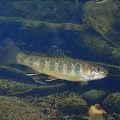A Black and White World

photo by Chester Allen
Twice each day, every trout stream in the world turns into a black-and-white movie.
This happens just before the sun rises in the morning — and just after it slides under the western ridges in the evening.
In my mind, this happens only in summer, when I’m up early to find trout finning in quiet backwaters and poking their noses out of the thick, gummy surface film to eat the dead, splayed bodies of caddis and mayfly spinners.
It happens again at dusk, when the trout slide into the shallow, slower currents near the bank to feed on hatching caddis, mayflies and midges. A bit later, the fish switch over to feeding on the mayfly spinners drifting down from the sky to lay their eggs.
Sometimes, a bit later, the rises grow bolder and sharper-edged, as the fish are chasing fast-moving caddis pupa.
Of course, the black-and-white hours happen every day of the year, but I only see them in summer, when sleep is less important than finding big trout porpoising or sticking their noses out of the water. On my Northwest rivers — and my favorite Yellowstone country waters — most of these big fish lurk in deep water most of the time.
If you don’t believe in this black-and-white world, go outside tonight after the sun drops below the horizon. Stand on a grass lawn. It looks pretty dark — almost black. Then turn on a flashlight. You’ve never seen grass so luridly green.
Anglers, ospreys, eagles, otters — so many trout enemies are out and about when the sun is high in the sky, and rich browns, yellows, greens and reds fill our eyes. For most trout, death is from above, and a sunlit river is a killing ground.
But when the world turns black and white, the trout — and many other gamefish — know they are almost invisible. And there is more food on the surface than any other time of day.
A Fleeting Glimpse
In Oregon — and a lot of other western states — legal fishing time starts one hour before sunrise and ends one hour after sunset.
So, I keep a printout of sunrise and sunset times in my vest. For example, I crept into a favorite backeddy at 4:45 a.m. on June 28. Legal sunrise was at 5:24 a.m., so I was legal.
What’s more, I was alone. Most fly anglers arrive onstream in the midmorning — right when mayfly duns are supposed to crack through the surface film.
Not many anglers are eager to get out of bed at 4 a.m. or earlier.
Many more anglers are eager to see the color wash out of the world at dusk. After all, they’re already awake and on the water. Still, I see many people leave the river an hour before it gets good.
In any case, the magic time at either end of the day is a short one. In the morning, the big fish ease out of the eddies when the first rays of the sun hit the banks and turn the tree leaves green. So, you usually get about 45 minutes of on-your-knees casting to big risers eating little dead bugs.
The evening is usually a little longer, especially if there is a half moon to full moon in the sky. When there’s a full moon, fish will feed on the surface all night. I set my cell phone alarm to an hour after sunset on those nights, so I don’t keep fishing and break the law.
When I camp on the river on a full-moon night, I can hear trout rising at 2 a.m. To my ears, those feeders sound like a scattered rain — big drops plopping onto the river. If you’re parked at the right spot, you can unzip the tent and see porpoising fish in the moonlight.
No, I don’t fall asleep. I lay awake, watch — and wait for legal fishing time.
The End of Something
On this same June 28 day, I returned to the water at 7 p.m., and I planned to fish until the legal fishing time ended at 10:03 p.m.
I found nice fish rising to a good caddis hatch, and I even managed to fool a couple of nice rainbow trout.
But I was sittlng at a favorite eddy by 8:15 p.m., watching the sun drop below the canyon wall.
I rigged two 4-weight rods with 12-foot 5X leaders. One got a size 14 X-Caddis. The other got a size 16 Iris caddis.
My drying patch held several size 16 Rusty Spinners — already knotted to 14-inch-long 5X tippets. It’s much easier to tie on a new tippet with a surgeon’s knot in the dusk than it is to thread on a new fly.
An hour later, only a few small fish were rising.
I could hear another angler babbling away at the rising trout a few hundred yards away. “Take it baby,” he yelled at the fish.
This is how it goes. One place lights up with rising fish, while others are quiet. Still, it’s best to pick a spot and stick with it, as it’s very hard to hook fish while you’re stumbling along the bank.
Sooner or later, the fish show up — at least most of the time.
On this night, the first nice rise rippled across the water at 9:15 p.m. I was pretty keyed up by that time, and I broke off another riser a few minutes later.
By then, the eddy was alive with rising trout.
I grabbed the other rod and showed the fish the Iris Caddis. A big head sucked it down on the third cast. The fish shook its head for a second — and then scorched out to the fast water and headed downstream.
I managed to coax it back into the eddy, where it dove for the weedy bottom — and then shot out into the fast water again.
The fish was back in the eddy a few minutes later — this was one of the big ones that I think about all winter long — and I was thinking about going for my net. The trout rolled on the surface and the fly pulled out.
Okay.
Well, @#$&.
I held the fly up to the moon. It looked fine — a tattered fly doused in shake is ideal during a caddis emergence — and there were plenty of trout banging away.
I retied the fly and gave it a trip into the shake canister.
Then my cell alarm went off. No more fishing on this black-and-white night.
I sat on the bank and watched those big trout boil on emerging caddis for an hour or so. Then their rises got very quiet and regular, which means that the rusty spinners were on.
As I sat there, watching trout rise like clockwork in a world without color, I wondered if this is what dying will be like. Do all the colors fade away, while you’re trying to do something you love — but you can’t do it anymore? Then the world gets black?
Yeah, it got pretty morbid.
Then I got up, turned on my flashlight and headed for camp. I would be back in about six hours — when the world turned black and white again.











